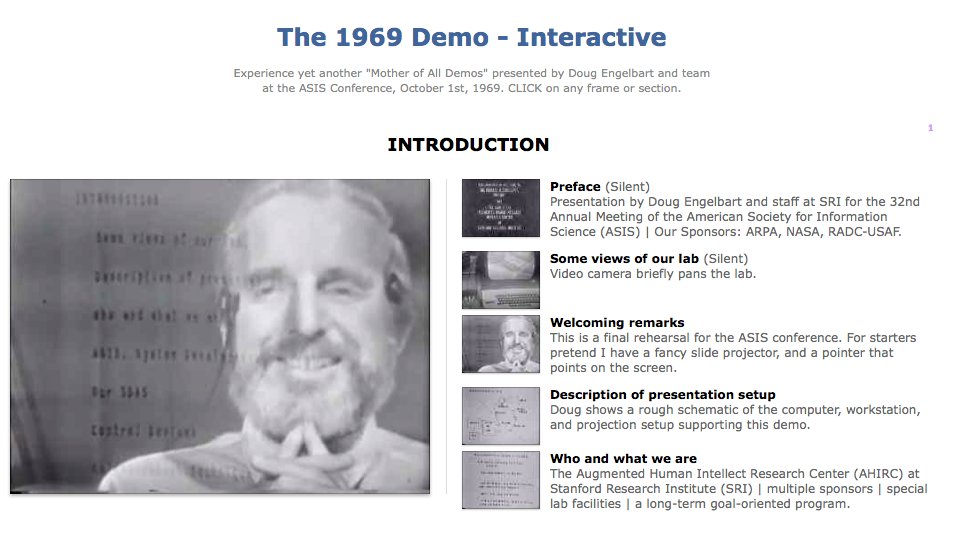Bret Victor: A few words about Douglas Engelbart
- Transfer

People often compare Engelbart's work with modern technology, but this is wrong. Forget about today, just think about what he did in terms of his goals.
Douglas Engelbart died today (July 3, 2013). His writings have always been very difficult to interpret and explain.
Many experts, unfortunately, often miss the essence of his work, because they consider everything as a technical task. Engelbart devoted his life to the problems of mankind, technology was only part of their solution. When I read expert interviews with Engelbart, I imagine how they would interview George Orwell asking deep questions about his typewriter.
Here is a great example of how Engelbart is superficially perceived - the headline in the New York Times:
Douglas Karl Engelbart - the creator of a computer mouse, died at the age of 88 years.
It is as if you took the person who invented writing, and called it the creator of the first pencil. (This analogy most accurately shows the essence of the problem.)
Here , for example, there is a list of his achievements:
His Online System (oN-Line System or NLS), demonstrated actual examples or prototypes of hypertext, screen collaboration, multiple working windows, video conferencing, and a mouse as an input device.
These are incorrect statements.
* * *
Engelbart had an intention, a goal, a mission. He outlined them clearly and in detail . Engelbart wanted to increase human intelligence . He wanted to strengthen the collective mind and allow mental workers to think in new ways so that they could collectively solve current global problems.
The problem with the statement that Engelbart "invented hypertext" or "invented video conferencing" is that you are trying to comprehend the past, relying on the present. “Hypertext” is a concept that has a specific meaning for us today. Saying that Engelbart invented hypertext, you equate the same meaning to the works of Engelbart.
Practically every time you interpret the past as “the same as the present, but more primitive and coarser”, you lose the meaning of the phenomenon. But in the case of Engelbart you lose the essence especially strongly.
Our hypertext is not the same as Engelbart hypertext because it is intended for other tasks. Modern video conferencing is not the same as Engelbart video conferencing, because they are also made for another. They may look similar in appearance but have different meanings. They can be called homophones , if you will be so clearer.
Here is an example:

Suppose you find his 1968 demonstration on YouTube and take a look. At some point, the face of a remote employee, Bill Paxton, appears on the screen. And Engelbart and Paxton are talking.
“Oh, it's like skype!”, You say.
Then Engelbart and Paxton begin to simultaneously work with the document on the screen.
“Oh, it's like working together with the screen!”, You say.
No, this is not at all like screen collaboration .
If you look closely, you will notice that there are two separate mouse pointers. Engelbart and Paxton each control their own pointer.
“Well,” you say, “they have separate mouse pointers, and when we show the general screen today, we have to fight for one pointer. It's nothing. In reality, they are one and the same. ”
No, they are not the same. Quite. This does not correspond to the project’s plan , and for understanding this is the most important thing.
Engelbart's vision from the very beginning was in teamwork. His idea is that people work together in a shared intellectual space (shared intellectual space). His whole system was designed around this intent.
From this point of view, the individual indicators were not so much a feature ( feature ), as a symptom (symptom) . It was the only sensible interface. It just fell out. Both employees had to point out the information on the screen in the same way that they pointed out the information on the board. Obviously , they need their own pointers.
This is true for every detail in the Engelbart system. The whole system was designed with a specific intention.
Our modern collaboration with the screen, on the other hand, is similar to “snapshot and product”, which does not change the single-user interface of our current computers. Our computers are fundamentally designed specifically for single-user use, and a simple remote mirror image of someone else's screen cannot magically convert them into a collaborative environment.
If you try to comprehend the ideas of Engelbart, drawing analogies with our modern systems, you miss the point, because our modern systems do not implement the ideas of Engelbart. Engelbart hated our modern systems.
* * *
If you really want to understand NLS, you must forget the reality of today. Forget everything you know about computers. Imagine that you still do not know what a computer is. Go back to 1962. And then read what he has in mind .
The least important question you can ask about Engelbart: “What did he create?” Asking this question, you can start to admire him, admire his achievements, adore him as a hero. But worship does not need anyone. Neither you nor him.
The most important question you can ask about Engelbart: “What kind of world did he try to create?” By asking this question, you can create such a world yourself.
Translation: Igor Popov
We translate to all Habrom the main document of Engelbart
Google translation with “Augmenting Human Intellect: A Conceptual Framework” here , can be supplemented.

Wall of engelbart
